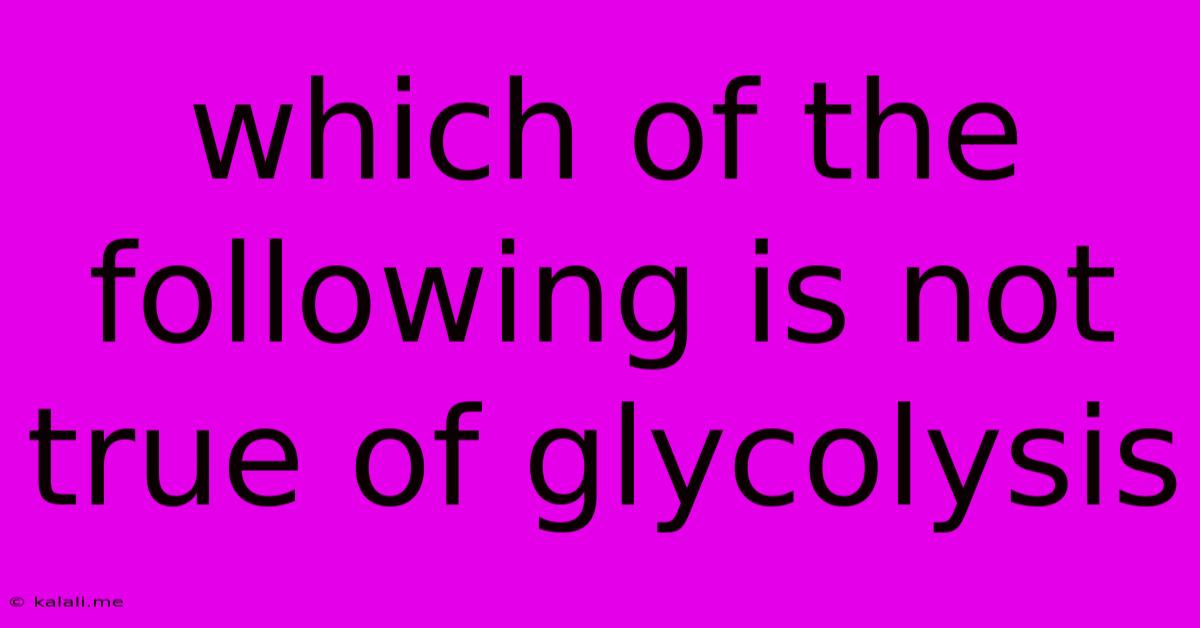Which Of The Following Is Not True Of Glycolysis
Kalali
Jun 14, 2025 · 3 min read

Table of Contents
Which of the Following is NOT True of Glycolysis? Debunking Common Misconceptions
Glycolysis, the metabolic pathway that breaks down glucose, is a cornerstone of cellular respiration. Understanding its intricacies is crucial for grasping fundamental biological processes. This article clarifies common misconceptions surrounding glycolysis by identifying statements that are not true about this vital pathway. We'll explore the nuances of glycolysis, explaining why certain claims are inaccurate and highlighting the key features that define this crucial process.
What is Glycolysis? A Quick Recap
Before diving into the inaccuracies, let's briefly review glycolysis. It's an anaerobic process, meaning it doesn't require oxygen, occurring in the cytoplasm of cells. The process involves a series of enzyme-catalyzed reactions that convert one molecule of glucose (a six-carbon sugar) into two molecules of pyruvate (a three-carbon compound). This conversion generates a net gain of two ATP (adenosine triphosphate) molecules and two NADH (nicotinamide adenine dinucleotide) molecules, which serve as energy carriers.
Statements that are NOT True of Glycolysis:
Here are some common statements about glycolysis that are often misunderstood or entirely incorrect:
-
Glycolysis requires oxygen: This is false. Glycolysis is an anaerobic process, meaning it can occur even in the absence of oxygen. While oxygen's presence significantly increases ATP production through subsequent processes like the Krebs cycle and oxidative phosphorylation, glycolysis itself does not require it. The process still functions in anaerobic conditions, albeit with a much lower net energy yield.
-
Glycolysis produces only ATP: This is an oversimplification. While ATP production is a major outcome, glycolysis also yields NADH, a crucial electron carrier involved in later stages of cellular respiration. NADH carries high-energy electrons that are essential for generating a much larger amount of ATP in the presence of oxygen. The NADH produced during glycolysis feeds into the electron transport chain.
-
Glycolysis occurs exclusively in the mitochondria: This is incorrect. Glycolysis takes place in the cytoplasm of the cell, not within the mitochondria. The mitochondria are the sites of the Krebs cycle and oxidative phosphorylation, the subsequent steps in aerobic cellular respiration.
-
Glycolysis directly produces large amounts of ATP: While glycolysis does produce ATP, the net yield is only two ATP molecules per glucose molecule. This is a relatively small amount compared to the total ATP produced during aerobic respiration, which involves glycolysis followed by the Krebs cycle and oxidative phosphorylation. The majority of ATP synthesis occurs in the electron transport chain, not during glycolysis itself.
-
Glycolysis is irreversible: While the pathway is heavily regulated, it's not entirely irreversible under all conditions. Certain metabolic pathways can utilize some of the intermediate products of glycolysis in a reversed manner, albeit under specific circumstances and cellular needs. Gluconeogenesis, for instance, is a pathway that can produce glucose from non-carbohydrate sources and involves some reversed steps of glycolysis.
Understanding the Importance of Glycolysis
Despite the limited ATP yield compared to aerobic respiration, glycolysis remains crucial for several reasons. It's a foundational metabolic pathway, providing the precursor molecules for further energy production in the presence of oxygen. Moreover, it provides a rapid source of ATP, even in the absence of oxygen, allowing cells to function under anaerobic conditions. This is vital for certain cell types and during periods of intense physical activity when oxygen supply may be limited.
By understanding the nuances and dispelling common misconceptions surrounding glycolysis, we gain a deeper appreciation for this fundamental process in cellular metabolism. The pathway's efficiency and adaptability ensure cell survival and energy production under a wide range of conditions.
Latest Posts
Latest Posts
-
Which Group Is The Most Reactive
Jun 14, 2025
-
What Is The Lcm Of 18 And 20
Jun 14, 2025
-
Which Of The Following Secrete Hydrochloric Acid
Jun 14, 2025
-
The Total Number Of Lobes In Both Lungs Is
Jun 14, 2025
-
Which Of The Following Is Not Associated With Animal Cells
Jun 14, 2025
Related Post
Thank you for visiting our website which covers about Which Of The Following Is Not True Of Glycolysis . We hope the information provided has been useful to you. Feel free to contact us if you have any questions or need further assistance. See you next time and don't miss to bookmark.